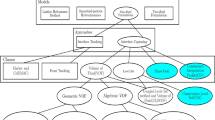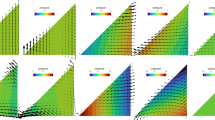Abstract
Fluid–structure interaction of flexible splitter plates attached to two rigid square cylinders, placed side-by-side in a uniform flow is studied. A partitioned approach is used to solve the fluid and structure problems. The results from the implementation are compared with earlier results on standard benchmarks. The Reynolds number based on the edge of the square cylinder is 100. The flexibility of the splitter plates is varied. Initially, the splitter plates undergo small amplitude oscillations that are out of phase relative to each other. The fully developed unsteady response shows in-phase variation. The frequency of the initial out-of-phase vibrations is found to be greater than the natural frequency of the structure. It approaches the natural frequency with increase in stiffness of the structure. The amplitude of the response of the structure is large when the dominant vibration frequency is close to its natural frequency. Lock-in/synchronization is observed for certain values of flexibility considered.




















Similar content being viewed by others
References
Mittal S, Kumar V, Raghuvanshi A (1997) Unsteady incompressible flows past two cylinders in tandem and staggered arrangements. Int J Numer Methods Fluids 25:1315–1344
Zdravkovich MM (1977) Review of flow interference between two circular cylinders in various arrangements. J Fluids Eng Trans ASME 99:618–633
Kim HJ, Durbin PA (1988) Investigation of the flow between a pair of circular cylinders in the flopping regime. J Fluid Mech 196:431–448
Wong PTY, Ko NWM, Chiu AYW (1995) Flow characteristics around two parallel adjacent square cylinders of different sizes. J Wind Eng Ind Aerodyn 54–55:263–275
Suqin C (2000) Numerical computation of the flow around two square cylinders arranged side-by-side. Appl Math Mech 21:147–164
Kwon K, Choi H (1996) Control of laminar vortex shedding behind a circular cylinder using splitter plates. Phys Fluids 8:479–486
Mansingh V, Oosthuizen PH (1990) Effects of splitter plates on the wake flow behind a bluff body. AIAA J 28:778–783
Kalro V, Tezduyar TE (2000) A parallel 3D computational method for fluid–structure interactions in parachute systems. Comput Methods Appl Mech Eng 190:321–332
Bazilevs Y, Takizawa K, Tezduyar TE (2013) Computational fluid–structure interaction: methods and applications. Wiley, Hoboken
Tezduyar TE, Behr M, Liou J (1992) A new strategy for finite element computations involving moving boundaries and interfaces—the deforming-spatial-domain/space-time procedure: I. The concept and the preliminary numerical tests. Comput Methods Appl Mech Eng 94:339–351
Tezduyar TE, Behr M, Mittal S, Liou J (1992) A new strategy for finite element computations involving moving boundaries and interfaces—the deforming-spatial-domain/space-time procedure: II. Computation of free-surface flows, two-liquid flows, and flows with drifting cylinders. Comput Methods Appl Mech Eng 94:353–371
Tezduyar TE (2003) Computation of moving boundaries and interfaces and stabilization parameters. Int J Numer Methods Fluids 43:555–575
Mittal S (2000) On the performance of high aspect-ratio elements for incompressible flows. Comput Methods Appl Mech Eng 188:269–287
Brooks AN, Hughes TJR (1982) Streamline upwind/Petrov–Galerkin formulations for convection dominated flows with particular emphasis on the incompressible Navier–Stokes equations. Comput Methods Appl Mech Eng 32:199–259
Tezduyar TE, Mittal S, Ray SE, Shih R (1992) Incompressible flow computations with stabilized bilinear and linear equal-order-interpolation velocity-pressure elements. Comput Methods Appl Mech Eng 95:221–242
Tezduyar TE, Behr M, Mittal S, Johnson AA (1992) Computation of unsteady incompressible flows with stabilized finite element methods: space-time formulations, iterative strategies and massively parallel implementations, New Methods in Transient Analysis, AMD Vol. 143, ASME, 7–24
Tezduyar TE, Aliabadi SK, Behr M, Johnson AA, Mittal S (1993) Parallel finite element computation of 3D flows. Computer 26:27–36
Johnson AA, Tezduyar TE (1994) Mesh update strategies in parallel finite element computations of flow problems with moving boundaries and interfaces. Comput Methods Appl Mech Eng 119:73–94
Dhondt G, Calculix: A free software three-dimensional structural finite element program http://www.calculix.de/
Dhondt G (2004) The finite element method for three-dimensional thermomechanical applications. Wiley, Hoboken
Harari I, Hughes TJR (1992) What are c and h?: inequalities for the analysis and design of finite element methods. Comput Methods Appl Mech Eng 97:157–192
Turek S, Hron J (2006) Proposal for numerical benchmarks for fluid-structure interaction between an elastic object and laminar incompressible flow. In: Fluid–structure interaction. Modelling, simulation and optimization, Lecture notes in computational science and engineering
Wall WA, Ramm E (1998) Fluidstructure interaction based upon a stabilized (ALE) finite element method. In: Idelsohn SR, Onate E (eds) 4th World congress on computational mechanics. CIMNE, Barcelona, Spain, Computational mechanics—New trends and applications, Buenos Aires, Argentina
Hubner B, Walhorn E, Dinkler D (2004) A monolithic approach to fluid–structure interaction using space-time finite elements. Comput Methods Appl Mech Eng 193:2087–2104
Dettmer W, Peric D (2006) A computational framework for fluidstructure interaction: finite element formulation and applications. Comput Methods Appl Mech Eng 195:5754–5779
Lee J, You D (2013) Study of vortex-shedding-induced vibration of a flexible splitter plate behind a cylinder. Phys Fluids 25(110811):1–17
Khalak A, Williamson CHK (1999) Motions, force and mode transitions in vortex induced vibrations at low mass damping. J Fluids Struct 13:813–851
Thomson WT, Dahleh MD (1997) Theory of vibration with applications, 5th edn. Prentice Hall, Upper Saddle River
Author information
Authors and Affiliations
Corresponding author
Rights and permissions
About this article
Cite this article
Furquan, M., Mittal, S. Flow past two square cylinders with flexible splitter plates. Comput Mech 55, 1155–1166 (2015). https://doi.org/10.1007/s00466-014-1110-5
Received:
Accepted:
Published:
Issue Date:
DOI: https://doi.org/10.1007/s00466-014-1110-5




